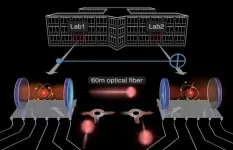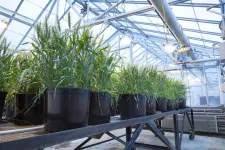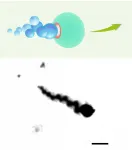Quantum systems learn joint computing
MPQ researchers realize the first quantum-logic computer operation between two separate quantum modules in different laboratories.
2021-02-24
(Press-News.org) Today's quantum computers contain up to several dozen memory and processing units, the so-called qubits. Severin Daiss, Stefan Langenfeld, and colleagues from the Max Planck Institute of Quantum Optics in Garching have successfully interconnected two such qubits located in different labs to a distributed quantum computer by linking the qubits with a 60-meter-long optical fiber. Over such a distance they realized a quantum-logic gate - the basic building block of a quantum computer. It makes the system the worldwide first prototype of a distributed quantum computer.
The limitations of previous qubit architectures
Quantum computers are considerably different from traditional "binary" computers: Future realizations of them are expected to easily perform specific calculations for which traditional computers would take months or even years - for example in the field of data encryption and decryption. While the performance of binary computers results from large memories and fast computing cycles, the success of the quantum computer rests on the fact that one single memory unit - a quantum bit, also called "qubit" - can contain superpositions of different possible values at the same time. Therefore, a quantum computer does not only calculate one result at a time, but instead many possible results in parallel. The more qubits there are interconnected in a quantum computer; the more complex calculations it can perform.
The basic computing operations of a quantum computer are quantum-logic gates between two qubits. Such an operation changes - depending on the initial state of the qubits - their quantum mechanical states. For a quantum computer to be superior to a normal computer for various calculations, it would have to reliably interconnect many dozens, or even thousands of qubits for equally thousands of quantum operations. Despite great successes, all current laboratories are still struggling to build such a large and reliable quantum computer, since every additionally required qubit makes it much harder to build a quantum computer in just one single set-up. The qubits are implemented, for instance, with single atoms, superconductive elements, or light particles, all of which need to be isolated perfectly from each other and the environment. The more qubits are arranged next to one another, the harder it is to both isolate and control them from outside at the same time.
Data line and processing unit combined
One way to overcome the technical difficulties in the construction of quantum computers is presented in a new study in the journal Science by Severin Daiss, Stefan Langenfeld and colleagues from the research group of Gerhard Rempe at the Max Planck Institute of Quantum Optics in Garching. In this work supported by the Institute of Photonic Sciences (Castelldefels, Spain), the team succeeded in connecting two qubit modules across a 60-meter distance in such a way that they effectively form a basic quantum computer with two qubits. "Across this distance, we perform a quantum computing operation between two independent qubit setups in different laboratories," Daiss emphasizes. This enables the possibility to merge smaller quantum computers to a joint processing unit.
Simply coupling distant qubits to generate entanglement between them has been achieved in the past, but now, the connection can additionally be used for quantum computations. For this purpose, the researchers employed modules consisting of a single atom as a qubit that is positioned amidst two mirrors. Between these modules, they send one single light quanta, a photon, that is transported in the optical fiber. This photon is then entangled with the quantum states of the qubits in the different modules. Subsequently, the state of one of the qubits is changed according to the measured state of the "ancilla photon", realizing a quantum mechanical CNOT-operation with a fidelity of 80 percent. A next step would be to connect more than two modules and to host more qubits in the individual modules.
Higher performance quantum computers through distributed computing
Team leader and institute director Gerhard Rempe believes the result will allow to further advance the technology: "Our scheme opens up a new development path for distributed quantum computing". It could enable, for instance, to build a distributed quantum computer consisting of many modules with few qubits that are interconnected with the newly introduced method. This approach could circumvent the limitation of existing quantum computers to integrate more qubits into a single setup and could therefore allow more powerful systems.
INFORMATION:
Original publication
Severin Daiss, Stephan Langenfeld, Stephan Welte, Emanuele Distante, Philip Thomas, Lukas Hartung, Olivier Morin, Gerhard Rempe
A Quantum-Logic Gate between Distant Quantum-Network Modules
Science 05 Feb 2021: Vol. 371, Issue 6529, pp. 614-617
[Attachments] See images for this press release:

ELSE PRESS RELEASES FROM THIS DATE:
2021-02-24
A new study, published today in Nature Digital Medicine, found that 'natural language processing' (NLP) of information routinely recorded by doctors - as part of patients' electronic health records - reveal vital trends that could help clinical teams forecast and plan for surges in patients.
The researchers from King's College London, King's College Hospital NHS Foundation Trust (KCH), and Guy's and St Thomas' Hospital NHS Foundation Trust (GSTT), used NLP algorithms to translate the electronic notes made by doctors into a standardised, structured set of medical terms that could be analysed by a computer.
Tracking trends in patients
In the ...
2021-02-24
Social distancing - from mobility restrictions to complete lockdowns -- can take many weeks, possibly even months, a potentially devastating outcome for social and economic stability. One of the challenges is that the sick cannot be selectively isolated, since many of the spreaders remain pre-symptomatic for a period ranging from several days to as much as two weeks - invisible spreaders who continue to be socially active. Hence, it seems that without a population-wide lockdown isolating the carriers cannot be achieved effectively.
To bypass this challenge, researchers from Israel's Bar-Ilan University, led by Prof. Baruch Barzel, devised a strategy based on alternating lockdowns: first splitting the population into two groups, then ...
2021-02-24
LOGAN, UTAH -- One solution to agriculture's many challenges -- climate change-induced drought, less arable land, and decreased water quality, to name a few -- is to develop smarter fertilizers. Such fertilizers would aim not only to nourish the plant but also to maximize soil bacteria's positive effects on the plant. Tapping into a plant's microbiome may be the extra layer of defense crops need to thrive.
In their study published on Dec. 4 in Nature: Scientific Reports, researchers at Utah State University analyzed the effects of two abiotic stressors on Pseudomonas chlororaphis O6 (PcO6), a health-promoting bacterium native ...
2021-02-24
URBANA, Ill. ¬- In today's global economy, production of goods depends on inputs from many trade partners around the world. Companies and governments need a deeper understanding of the global value chain to reduce costs, maintain a profitable production system, and anticipate ripple effects of disruptions in the supply chain.
Applied economists from the University of Illinois have developed a new model for in-depth analysis of global supply chain linkages across countries and industries, providing a rich tool that delivers valuable insights for businesses and policy makers around the world.
"We live in a time when production processes are very much fragmented. In order to end up with one type of ...
2021-02-24
Researchers have developed a method to estimate the value of oyster and clam aquaculture to nitrogen reduction in a coastal community. Nitrogen is a nutrient that comes from many different sources, including agriculture, fertilizers, septic systems, and treated wastewater. In excess it fuels algal growth, which can affect water quality and human health.
As a result, a growing number of communities are required to follow regulations to reduce the amount of nitrogen they release. Shellfish are an option that can be a valuable part of a community's nutrient management plan.
In a study in Environmental Science ...
2021-02-24
A UNSW Sydney-led medical research team has called for a new vaccine, improved strategies and enhanced monitoring to combat serious complications from childhood pneumonia.
The researchers examined the impact of the 13-valent pneumococcal conjugate vaccine (13vPCV) on childhood pneumonia and empyema - complicated pneumonia - after its introduction to the Australian National Immunisation Program about a decade ago.
The new study, published in Thorax recently, found that while 13vPCV resulted in a 21 per cent decrease in childhood pneumonia hospitalisations, there was a contemporaneous 25 per cent increase in admissions for empyema.
This incidence data for childhood empyema hospitalisations is similar to that reported ...
2021-02-24
For many, 2020 was notorious for the COVID-19 pandemic, but for climate scientists, the year is also infamous for tying with 2016 as the hottest since records began. 'Nine of the warmest years on record have occurred since 2010', says JEB Editor-in-Chief, Craig Franklin. With the ice caps and glaciers melting, devastating bushfires scorching arid regions, and hurricanes and typhoons battering coastal communities, the impact on local ecosystems has been catastrophic. 'Physiologists can play a critical role in the conversation around climate change', says ...
2021-02-24
As part of the Journal of Experimental Biology's Special Issue dedicated to climate change, Anthony Pagano (San Diego Zoo Global, USA) and Terrie Williams (University of California, Santa Cruz, USA), discuss the impact of environmental change on two iconic polar species; the polar bear and narwhal. Their review article is published in Journal of Experimental Biology at https://jeb.biologists.org/content/224/Suppl_1.
Mammals in the Polar Regions face an uncertain future as unprecedented warming drives catastrophic sea ice loss, driving polar bears onto land, after losing access to sea ice and ...
2021-02-24
Rheumatoid arthritis is a chronic inflammatory disorder marked by joint pain, swelling and damage. Although medications, such as steroids, anti-inflammatory drugs and immunosuppressants, can help slow joint destruction and relieve pain, they have side effects and aren't completely successful. Now, researchers reporting in ACS' Nano Letters have developed magnesium-based micromotors propelled by hydrogen bubbles, which improved rheumatoid arthritis symptoms when injected into the joints of rats.
Scientists have linked rheumatoid arthritis development to the excess production of reactive oxygen species (ROS). ROS can oxidize and degrade cartilage and bone, as well as activate the expression of inflammatory cytokines. A new type of therapy, hydrogen gas, can neutralize ROS ...
2021-02-24
To come into being, galaxies need a steady diet of cold gases to undergo gravitational collapse. The larger the galaxy, the more cold gas it needs to coalesce and to grow.
Massive galaxies found in the early universe needed a lot of cold gas--a store totaling as much as 100 billion times the mass of our sun.
But where did these early, super-sized galaxies get that much cold gas when they were hemmed in by hotter surroundings?
In a new study, astronomers led by the University of Iowa report direct, observational evidence of streams of cold gas they believe provisioned these early, massive galaxies. They detected cold gas pipelines that knifed through the hot atmosphere in the dark matter halo of an early massive galaxy, supplying the materials ...
LAST 30 PRESS RELEASES:
[Press-News.org] Quantum systems learn joint computing
MPQ researchers realize the first quantum-logic computer operation between two separate quantum modules in different laboratories.




